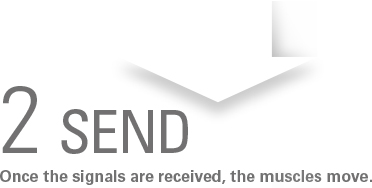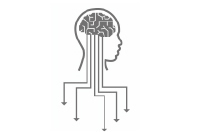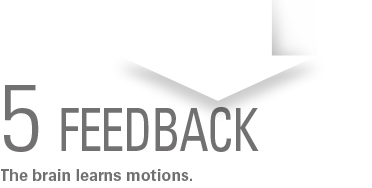HAL® is the world's first cyborg-type robot, by which a wearer's bodily functions can be improved, supported and enhanced.
Wearing HAL® leads to a fusion of “man”, “machine” and “information”. HAL® assists a physically challenged person's movements and enables him or her to exert greater motor energy than usual. HAL® is also considered to be a system that accelerates the motor learning of cerebral nerves. Application of HAL® to various fields, such as motion assistance in the nursing care field, assistance with heavy labor in factories and assistance with activities on disaster sites, is prospected.
Major causes of lower limb disabilities are disorders of the neuromuscular system. In those cases, the brain cannot use ordinary neural pathways and cannot order the legs to move.
HAL® for Medical Use (Lower Limb Type) is the only robotic remedial device that can teach the brain how to move the legs.
When a person moves their body, various signals are sent from the brain to the muscles through nerves. Those signals leak onto the skin surface as bio-electric signals (“BES”). HAL® for Medical Use (Lower Limb Type) reads the wearer's BES, compensates muscle power of the lower limbs accordingly, and assists the wearer with walking, standing up and sitting down using his or her own legs.


When a person moves their body, he or she first thinks about the motions in their brain. By thinking “I want to walk,” the brain transmits necessary signals for movement to the muscles through nerves.
The speed of signals that are conveyed from the brain to each muscle is approximately between 150 km/h and 400 km/h, which is far beyond the speed of a Shinkansen bullet train.
The technology to recognize and understand those high-speed signals at a glance is indispensable for HAL®.


In a healthy body, each muscle is able to receive signals from the brain and move as strongly and as fast as intended.
In order to produce complex bodily motions for walking, the brain controls a number of muscles based on various types of information from the whole body. The device that was developed as an application of this principle was HAL®.


Signals sent to muscles by the brain leak onto the skin surface as very faint signals known as BES. HAL® is able to read BES by attaching originally developed detectors on the surface of the wearer's skin. By consolidating various types of information, HAL® recognizes what type of motion the wearer intends to make.
BES that leaks onto the skin surface is very feeble. Its voltage ranges from 1/1000th to 1/100,000th of the voltage exerted by dry batteries.
Since HAL® is able to detect such weak signals, it does not overlook the wearer's extremely subtle indicators that fail to cause flexion in the leg.


HAL®, in accordance with the recognized signals, controls its power units*2.
This function enables HAL® to assist the wearer's motions as he or she intends by exerting greater power than he or she ordinarily can.
*2 HAL® preforms assistance for the wearer's motions through a combination of the Cybernic Voluntary Control (“CVC”) system, with which HAL® moves in line with the wearer's intent by detecting BES, and the Cybernic Autonomous Control (“CAC”) system, with which HAL® replicates human motions based on fundamental motion patterns in the absence of BES. This is the advanced technology on which HAL® is founded.
Human thoughts in the brain that control muscles and move joints are extremely rapid. HAL®, like man, is able to process all kinds of information instantly to apply its power unit. When the body starts moving, HAL® moves simultaneously, and is thereby able to assist the wearer's motions.

The mechanism to move the human body does not end with the movement of the muscles. The brain confirms how the body moved in response to the type of signals it sent. When HAL® has appropriately assisted the motions of walking, the feeling “I could walk!” is fed back to the brain. In this way, the brain is gradually able to learn the proper way to emit the necessary signals for walking. This feedback loop leads to “the important first step” in walking without the assistance of HAL® for a physically challenged person. The only robot that can provide the brain the appropriate solutions for movement is HAL®.
COPYRIGHT ©2004~2015 CYBERDYNE INC. ALL RIGHTS RESERVED.